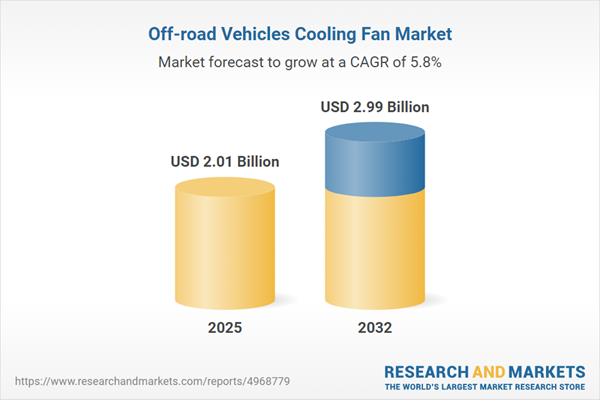Speak directly to the analyst to clarify any post sales queries you may have.
Senior decision-makers in the off-road vehicles cooling fan market are navigating a sector that demands adaptability, with innovation and complex procurement strategies driving success. Modern supply chains and regulatory pressures intensify the need for forward-thinking approaches that secure robust operational outcomes.
Market Snapshot: Off-road Vehicles Cooling Fan Market
The global off-road vehicles cooling fan market was valued at USD 1.90 billion in 2024 and is projected to reach USD 2.99 billion by 2032, attaining a compound annual growth rate (CAGR) of 5.83%. Robust investment in research and development is sustaining this ascent, with manufacturers prioritizing advanced fan designs that utilize intelligent controls and resilient materials. Products are being refined to cater to stringent performance requirements, adapting to a wide range of off-road vehicle categories, both industrial and recreational. Continuous updates in design and technology enable firms to meet rapidly shifting operational and environmental conditions, emphasizing the strategic importance of flexibility.
Scope & Segmentation of the Off-road Vehicles Cooling Fan Market
A comprehensive view of market segmentation empowers leaders to optimize investments and strategically align with evolving sector demands. The off-road vehicles cooling fan market is shaped by distinct needs across product types, applications, and geographic regions, making segmentation a crucial tool for risk management and innovation.
- Vehicle Types: All-terrain vehicles, dirt bikes, side-by-side vehicles, snowmobiles, and utility task vehicles each present unique cooling performance expectations and demand customized solutions to support their diverse operating environments and end-user requirements.
- Fan Types: Axial, centrifugal, and crossflow fans provide varied airflow characteristics, allowing for tailored integration into different system designs, whether standard or specialized for demanding applications.
- Power Sources: Electric brushed, brushless, mechanical belt-driven, and direct-drive configurations enable companies to choose the most suitable approach for reliability, efficiency, or maintenance optimization, depending on application profile.
- End Users: Original equipment manufacturers and aftermarket customers each influence technology trends, procurement preferences, and the rise of digital sourcing channels.
- Regional Coverage: The Americas, Europe, Middle East & Africa, and Asia-Pacific face distinctive legal frameworks, regional sourcing strategies, and supply chain complexities that directly impact competitive approaches and regulatory compliance requirements.
- Companies Profiled: Denso Corporation, Valeo SA, BorgWarner Inc., MAHLE GmbH, Nidec Corporation, Gentherm Incorporated, Visteon Corporation, Marelli Holdings Co., Ltd., SPAL Automotive S.R.L., and Behr Hella Service GmbH are recognized for their roles in advancing sector technology and establishing leadership positions.
Key Takeaways
- Ongoing product development is prioritizing compliance and enhanced reliability, supporting use in both heavy-duty and recreational off-road settings.
- The industry is experiencing a move toward brushless motor technologies and the adoption of new composite materials, which are strengthening product longevity and minimizing required maintenance over the lifecycle.
- Integrated digital controls in modern cooling systems are offering real-time operational oversight and helping manufacturers align with changing regulatory requirements.
- Collaboration between equipment manufacturers and supply partners fosters flexible, custom designs that respond effectively to evolving vehicle architectures and market demands.
- Digital procurement systems are simplifying sourcing operations and enhancing conformity with regional legal frameworks, supporting more resilient global supply strategies.
- Research and development efforts are increasingly directed toward achieving quieter operation and incorporating advanced safety features to meet rising regulatory and operational expectations.
Tariff Impact: Effects of United States Policy Adjustments
Adjustments in U.S. tariff policy have increased costs associated with key cooling fan components and materials. In response, companies are identifying alternative sourcing channels, developing closer ties with domestic suppliers, and choosing modular product designs. These adaptive strategies aim to sustain uninterrupted manufacturing and agility during changes in trade conditions.
Methodology & Data Sources
This analysis draws directly from feedback provided by procurement and engineering professionals, as well as in-depth reviews of industry standards. The evaluation framework emphasizes benchmarks for system efficiency, noise management, and product durability, supplying decision-makers with actionable metrics for regulatory and operational alignment.
Why This Report Matters: Off-road Vehicles Cooling Fan Market
- Equips executives with the intelligence to address emerging technology, evolving regulatory environments, and global supply chain complexities in the off-road vehicles cooling fan market.
- Identifies key drivers influencing sourcing, capital deployment, and risk mitigation, emphasizing innovation in cooling systems and improvements in engineering.
- Prepares leadership to anticipate and respond to compliance and operational shifts, supporting swift adaptation in a sector undergoing rapid change.
Conclusion
By leveraging these insights, senior decision-makers can develop resilient, adaptive strategies that reinforce operational performance and support sustained growth in the off-road vehicles cooling fan market.
Additional Product Information:
- Purchase of this report includes 1 year online access with quarterly updates.
- This report can be updated on request. Please contact our Customer Experience team using the Ask a Question widget on our website.
Table of Contents
3. Executive Summary
4. Market Overview
7. Cumulative Impact of Artificial Intelligence 2025
Companies Mentioned
The companies profiled in this Off-road Vehicles Cooling Fan market report include:- Denso Corporation
- Valeo SA
- BorgWarner Inc.
- MAHLE GmbH
- Nidec Corporation
- Gentherm Incorporated
- Visteon Corporation
- Marelli Holdings Co., Ltd.
- SPAL Automotive S.R.L.
- Behr Hella Service GmbH
Table Information
| Report Attribute | Details |
|---|---|
| No. of Pages | 186 |
| Published | November 2025 |
| Forecast Period | 2025 - 2032 |
| Estimated Market Value ( USD | $ 2.01 Billion |
| Forecasted Market Value ( USD | $ 2.99 Billion |
| Compound Annual Growth Rate | 5.8% |
| Regions Covered | Global |
| No. of Companies Mentioned | 11 |









